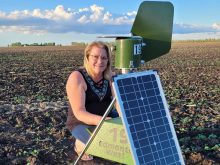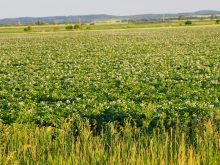Glacier FarmMedia – New ways to control Colorado potato beetles are marrying pheromones, volatiles and potentially natural repellants.
“We’re trying to create what we’d call a push-pull system, where you have something attractive, like the pheromones and potato volatiles, to attract them into a trap … and you have something repellent that would push them away from the field,” said Rebecca Hallett, a professor with the University of Guelph’s School of Environmental Sciences.
An effective aggregation pheromone trap and a perimeter or in-row repellency strategy could minimize beetle populations and yield impacts early on.
Read Also

Pakistan reopens its doors to Canadian canola
Pakistan reopens its doors to Canadian canola after a three-year hiatus.
Hallett, the principal investigator, said it’s the first study evaluating different Colorado potato beetle pheromone combinations, release rates and effectiveness of pheromone and potato volatile kairomones, which attract pests to host plants, since it was isolated in the early 2000s, particularly within an operational field setting, either at the field edge or in-row.
“It’s an aggregation pheromone. If we can increase the attraction of males and particularly females to these lures … there’s quite a high potential to impact potato beetle populations and reduce yield effects, but it’s dependent on getting that really attractive blend of compounds,” she said.
Andy Colton, an entomology Ph.D. student, said lab studies of the original pheromone showed lower than anticipated attraction rates, requiring significant investment to purify and improve the synthetic pheromone before they could initiate field-level research.
Colton said thousands of beetles responded to pheromone traps in one of the two test sites, which, to his knowledge, was a first with wild beetles.
“One of our strategies is to deploy traps around the perimeter and hope to intercept (the beetles) when they emerge,” he said, adding Colorado potato beetles overwinter in field margins, emerging in May to June.
Ideally, perimeter traps combined with in-row integration will attract emerging pests early on and lure survivors off host plants, diminishing the beetle population.
“(This) is more difficult. There are definitely stages of the season where they’re more primed for the pheromone and host volatiles,” Colton said.
“We’re finding different results at different stages.”
The first in-field trials provided insight into the aggregation pheromone traps, but more work still needs to be done.
“Colorado potato beetle is a global pest, so if it (the new pheromone) works, it may very well be economically feasible (to scale production),” Hallett said.
“But at this point, it’s too early to say. It’s been expensive trying to get this synthesis done properly.”
Colton’s lab research on the efficacy of high volatile plant compounds from hops and cannabis byproducts as a repellent is in its infancy.
“Cannabis, in particular, is very high in terpenes, and some research has suggested that the presence of non-host volatiles may deter pest activity,” he said.
Colorado potato beetle females are picky about where they lay eggs, and early lab research indicates cannabis could interrupt feeding and egg-laying patterns, but it has some challenges.
“The regulations are tight (with cannabis), so working with it has been difficult,” he said.
“I’m excited to get my hands on some hops because it’s an aromatic plant in a similar family, so there could be activity.”
The repellency mulch, sourced from cannabis and craft beer market byproducts, could provide a knock-on value for the industry’s waste products.
Hallett anticipates field-level cannabis mulch trials will likely begin this year. As well, trap deployment research will continue to identify the ideal location and beetle interception timing.
Growers interested in participating in in-field research are encouraged to contact Colton.
“Colorado potato beetle is a global pest, so if it (the new pheromone) works, it may very well be economically feasible (to scale production),” Hallett said.
“But at this point, it’s too early to say. It’s been expensive trying to get this synthesis done properly.”















